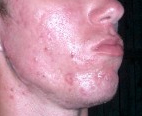Stages of Acne
1. Mild acne —
The first choice of topical antibiotics in terms of efficacy and relative lack of induction of resistant P acnes is the combination of erythromycin or clindamycin with benzoyl peroxide topical gel. Clindamycin (Cleocin T) lotion (least irritating), gel, or solution, or one of the many brands of topical erythromycin gel or solution, may be used twice daily and the benzoyl peroxide in the morning. (A combination of erythromycin or clindamycin with benzoyl peroxide is available as a prescription item.) The addition of tretinoin 0.025% cream or 0.01% gel at night may be effective, since it works via a different mechanism.
2. Moderate acne —
Tetracycline, 500 mg twice daily, doxycycline, 100 mg twice daily, and minocycline, 50-100 mg twice daily, are all effective though minocycline is more expensive. When initiating minocycline therapy, start at 100 mg in the evening for 4-7 days, then 100 mg twice daily, to decrease the incidence of vertigo. Plan a return visit in 6 weeks and at 3-4 months after that. If the patient's skin is quite clear, instructions should be given for tapering the dose by 250 mg for tetracycline and erythromycin, by 100 mg for doxycycline, or by 50 mg for minocycline every 6-8 weeks — while treating with topicals — to arrive at the lowest systemic dose needed to maintain clearing. In general, lowering the dose to zero without other therapy results in prompt recurrence of acne. Tetracycline, minocycline, and doxycycline are contraindicated in pregnancy, but oral erythromycin may be used.
It is important to discuss the issue of contraceptive failure when prescribing antibiotics for women taking oral contraceptives. Women may need to consider using barrier methods as well, and should report breakthrough bleeding. Oral contraceptives or spironolactone (50-200 mg daily) may be added as an antiandrogen in women with antibiotic-resistant acne or in women in whom relapse occurs after isotretinoin therapy.
3. Severe acne —
a. Isotretinoin (Accutane) —
A vitamin A analog, isotretinoin is used for the treatment of severe cystic acne that has not responded to conventional therapy. Informed consent must be obtained before its use. A dosage of 0.5-1 mg/kg/d for 20 weeks for a cumulative dose of at least 120 mg/kg is usually adequate for severe cystic acne. Patients should be offered isotretinoin therapy before they experience significant scarring if they are not promptly and adequately controlled by antibiotics. The drug is absolutely contraindicated during pregnancy because of its teratogenicity; two serum pregnancy tests should be obtained before starting the drug in a female and every month thereafter. Sufficient medication for only 1 month should be dispensed. Two forms of effective contraception must be used. Side effects occur in most patients, usually related to dry skin and mucous membranes (dry lips, nosebleed, and dry eyes). If headache occurs, pseudotumor cerebri must be considered. Depression has been reported. About 25% of patients will develop hypertriglyceridemia, 15% hypercholesterolemia, and 5% a lowering of high-density lipoproteins. Some patients develop minor elevations of liver function tests. Fasting blood sugar may be elevated. Miscellaneous adverse reactions include decreased night vision, musculoskeletal or bowel symptoms, dry skin, thinning of hair, exuberant granulation tissue in lesions, and bony hyperostoses (seen only with very high doses or with long duration of therapy). Moderate to severe myalgias necessitate decreasing the dosage or stopping the drug. Laboratory tests to be performed in all patients before treatment and after 4 weeks on therapy include cholesterol, triglycerides, and liver function studies.
Elevations of liver enzymes and triglycerides return to normal upon conclusion of therapy. The drug may induce long-term remissions in 40-60%, or acne may recur that is more easily controlled with conventional therapy. Occasionally, acne does not respond or promptly recurs after therapy, but it may clear after a second course.
b. Intralesional injection —
In otherwise moderate acne, intralesional injection of dilute suspensions of triamcinolone acetonide (2.5 mg/mL, 0.05 mL per lesion) will often hasten the resolution of deeper papules and occasional cysts.
c. Laser, dermabrasion —
Cosmetic improvement may be achieved by excision and punch-grafting of deep scars and by abrasion of inactive acne lesions, particularly flat, superficial scars. The technique is not without untoward effects, since hyperpigmentation, hypopigmentation, grooving, and scarring have been known to occur. Dark-skinned individuals do poorly. Corrective surgery within 12 months after isotretinoin therapy may not be advisable.
CMDT 2006

No comments:
Post a Comment